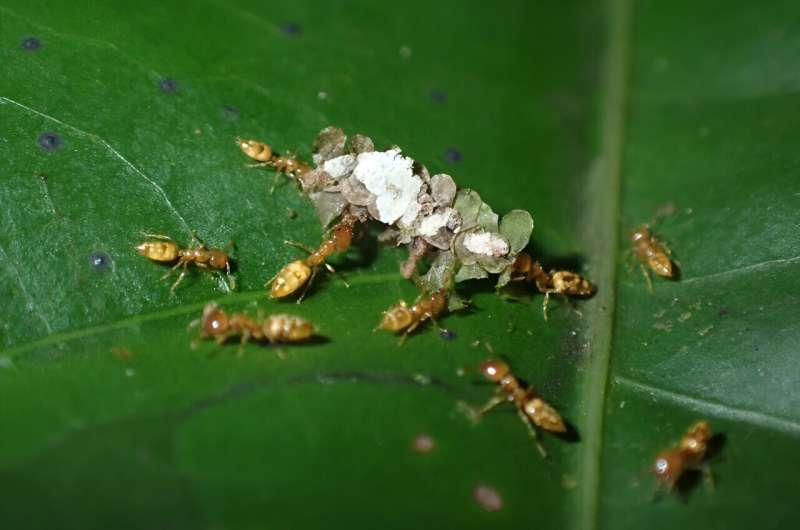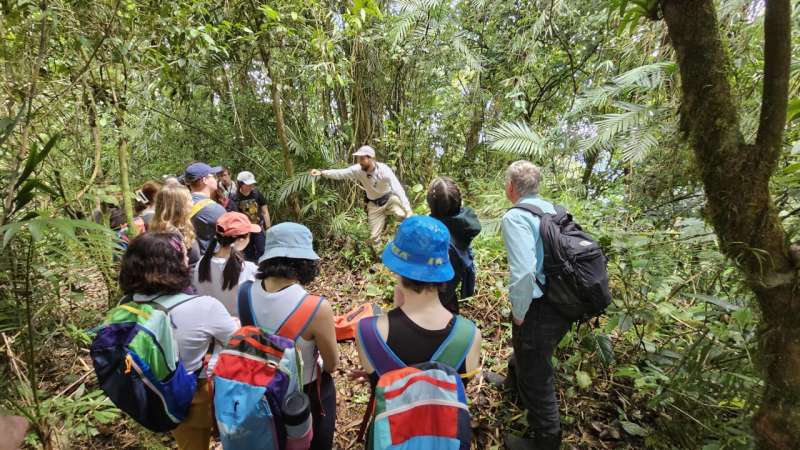
Myrmelachista ants, which excavate nesting cavities in living tree stems, keep understory leaves free of debris and pathogens. Credit: Rodolfo Probst, University of Utah
Ants are famous for their regimented and complex social behaviors. In the tropics, they are also famous for forming mutualisms with plants. Certain species of trees have conspicuous hollow swellings that house ants, often feeding the ants with specialized ant food. In return, the ants are pugnacious bodyguards, swarming out to aggressively defend the plant against enemies. Scientists have observed these mutualisms for centuries, but an enduring question is how these intriguing interactions evolved in the first place.
That remains a mystery, but new research led by University of Utah field biologist Rodolfo Probst offers insights that could broaden our understanding of ant-plant symbioses.
Published in the Proceedings of the Royal Society B, his research focused on an ant genus called Myrmelachista. Most Myrmelachista species nest in dead or live stems of plants, without any specialized mutualistic association. But one group of species in Central America was known to nest only in the live stems of certain species of small understory trees, in a specialized symbiosis similar to other ant-plant mutualisms. These tiny yellow ants hollow out the stems without harming the host plants, and can be found throughout Central America.
Such symbiosis requires complex and novel behaviors and morphology (physical characteristics such as color, shape and size), and is thought to occur infrequently. The Central American specialists were a cluster of nine species that all shared these complex traits and were only slightly different from each other. It was assumed that a single common ancestor must have evolved the symbiosis over a long period of time, and these were very young species that had emerged after the symbiosis had evolved.
Probst made a remarkable discovery. Using DNA sequence data to unravel their evolutionary history, he found that these nine species occurred as two clusters in different parts of the evolutionary tree. That means that this complex relationship, with all its distinctive characteristics, evolved twice from non-specialist ancestors. Not only that, but they also evolved in close proximity, and at about the same time, around 3 million years ago.
“I wish I could just take a time machine and see it,” Probst said. “Maybe it was the ecology or plant availability that helped those friendships evolve in the first place.”

Biologist Rodolfo Probst leads University of Utah students on field research trip in Costa Rica. Credit: University of Utah
He argues this is a case of convergent evolution, where unlike species evolve to be more similar, often because they occupy similar specialized ecological niches. Think whales and fish. Somehow, these ants developed the same behavior in what Probst dubbed “evolutionary déjà vu.”
“They look so similar that the parsimonious assumption was that this mutualism might have evolved once,” Probst said. “The coolest part of our paper is that we’re showing that these types of ant-plant friendships evolve multiple times independently. Is that evolutionary déjà vu? It’s like if it happens, it might happen again if you’re given the appropriate ecological conditions.”
His two co-authors are renowned entomologist Jack Longino, better known among U students as The Astonishing Ant Man for his expertise and vast personal collection of ant specimens kept on campus, and former U School of Biological Sciences’ postdoctoral researcher Michael Branstetter, now with U.S. Department of Agriculture’s Pollinating Insect Research Unit at Utah State University.
“The main story in this paper is the unexpected part. Rodolfo’s work revealed two independent evolutions of a complex relationship with plants. It suggests that the developmental building blocks for very distinctive or complex features are readily at hand, and can quickly evolve among different sets of species when the conditions arise,” said Longino, a U professor of biology who has spent more than four decades studying ants, mostly in tropical regions.
“Morphology alone has never been good at revealing relationships among species, the evolutionary pageant that is how life has diversified on the planet.”
With continuing help from the university’s Science Research Initiative undergraduates, Probst is looking to conduct whole genomic sequencing to tease out the genes involved in ant-plant associations, looking “under the hood” of a phenomenon that has intrigued naturalists for centuries.
More information:
Rodolfo S. Probst et al, Evolutionary déjà vu? A case of convergent evolution in an ant–plant association, Proceedings of the Royal Society B: Biological Sciences (2024). DOI: 10.1098/rspb.2024.1214
Citation:
Of ants and trees: ‘Evolutionary déjà vu’ in the tropical rainforest (2024, July 18)
retrieved 19 July 2024
from https://phys.org/news/2024-07-ants-trees-evolutionary-dj-vu.html
This document is subject to copyright. Apart from any fair dealing for the purpose of private study or research, no
part may be reproduced without the written permission. The content is provided for information purposes only.
>>> Read full article>>>
Copyright for syndicated content belongs to the linked Source : Phys.org – https://phys.org/news/2024-07-ants-trees-evolutionary-dj-vu.html






























